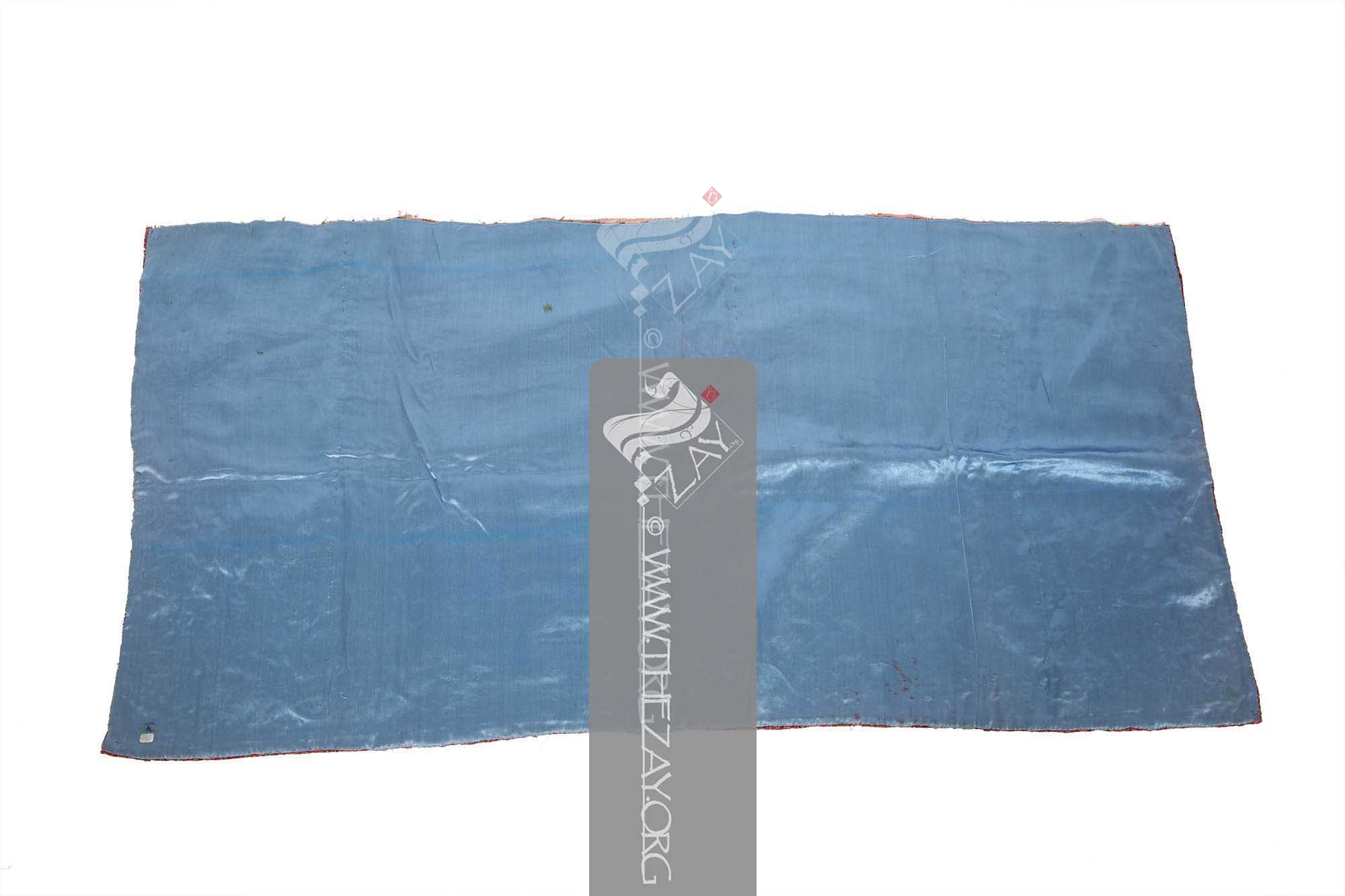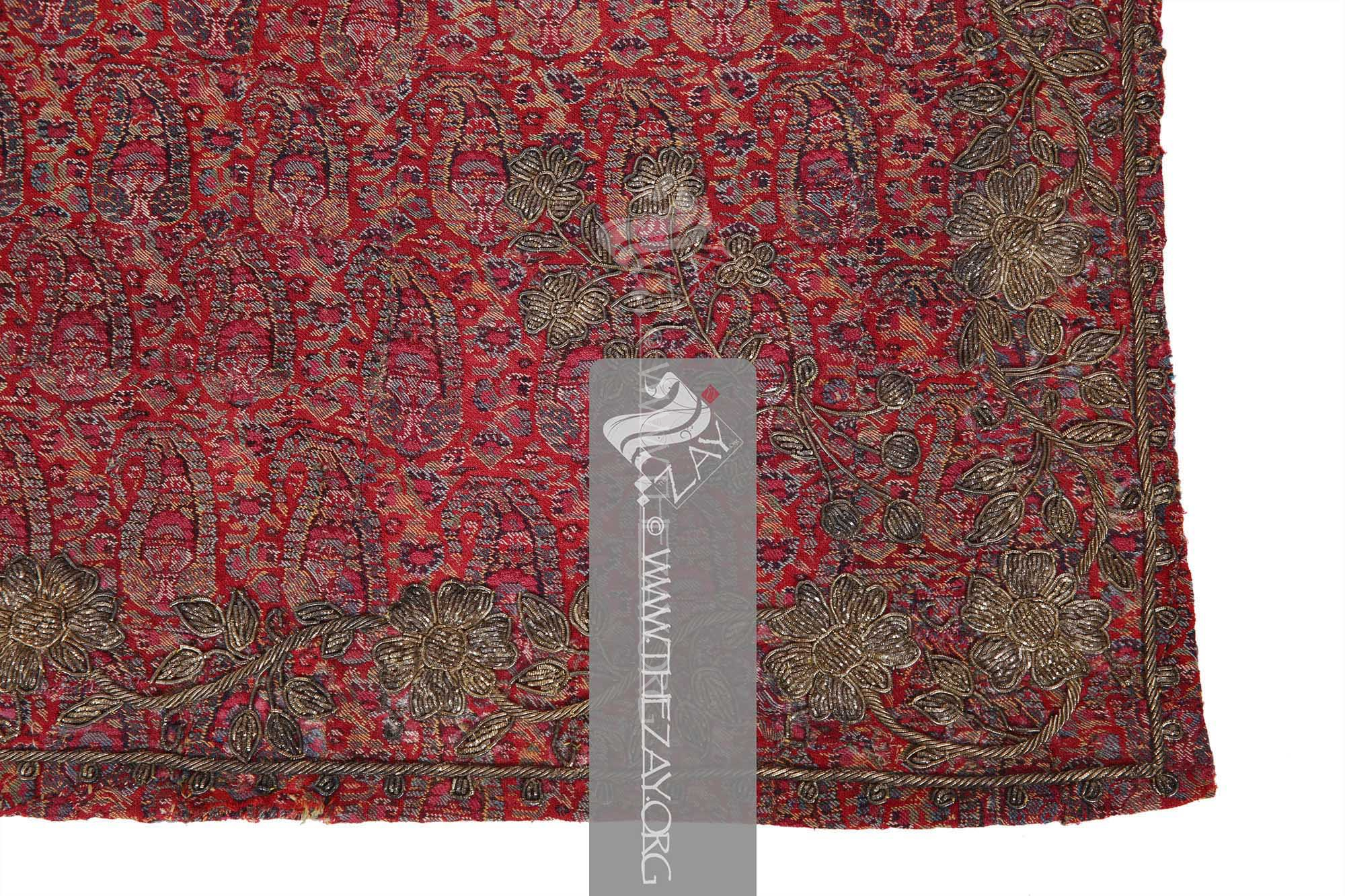Object History This fabric panel was purchased by
Dr. Reem Tariq
Ṭariq: (Arabic; Synonym: tulle_bi_talli
Tūlle_bi_tallī: (French: Tulle – a city in France where fine material for veil was first made; Turkish: tel – wire; Synonym: tariq; talli; badla; khus_dozi ), series of small metal knots made on a woven net ground as embellishment. The term is commonly used in the North African Arab region specifically in Egypt.
; talli; badla; khus_dozi ), series of small metal knots made on a woven net ground as embellishment. The term is commonly used in the Levant Arab region specifically in Lebanon.
El Mutwalli
Dr. Reem Tariq
Ṭariq: (Arabic; Synonym: tulle_bi_talli
Tūlle_bi_tallī: (French: Tulle – a city in France where fine material for veil was first made; Turkish: tel – wire; Synonym: tariq; talli; badla; khus_dozi ), series of small metal knots made on a woven net ground as embellishment. The term is commonly used in the North African Arab region specifically in Egypt.
; talli; badla; khus_dozi ), series of small metal knots made on a woven net ground as embellishment. The term is commonly used in the Levant Arab region specifically in Lebanon.
el Mutwallī: Founder (CEO) of the Zay
Zay: (Arabic: costume, Pl. azyaā’), a set of clothes in a style typical of a particular country or historical period. Initiative, a public figure, speaker and author. An expert curator and consultant in Islamic art and architecture, interior design, historic costume, and UAE heritage. from an independent dealer in the UK in 2017 to add to and enhance The
Zay
Zay: (Arabic: costume, Pl. azyaā’), a set of clothes in a style typical of a particular country or historical period. Initiative collection.
Object Features This is a piece of woven woollen fabric panel with intricate and dense designs on a (
madder
Madder: (Latin: Rubia tinctorum – Eurasian herb), rose madder, common madder or dyer's madder is a vegetable dye made from the roots of a perennial plant belonging to the bedstraw and coffee family. It has been used extensively as a vegetable red dye across the globe from India to England.
) red base in a multitude of colours – yellow, (
turquoise
Turquoise: (French: turquois – present day Türkiye; Synonyms: firuze, pheroza), is a naturally occurring opaque mineral mined in abundance in Khorasan province of Iran and has been used for making dye for centuries. The term is a derivative of the French word for the country Türkiye once called Turkey. ) blue, and black – and embroidered embellishment in metallic, possibly silver bullion thread in (
couching
Couching: (Latin: collocare – Place together), in needlework and embroidery couching is a technique in which yarn or other materials are laid across the surface of the ground fabric and fastened in place with small stitches of the same or a different yarn
) style.
The panel is constructed out of multiple similar pieces of fabric patched together with darning. It has a repeat of medium-sized floral and (
paisley
Paisley: (Scottish Gaelic, Pàislig: a town in Scotland), often called buta, boteh, amli, or kalgi in the subcontinent and kazuwah in Arabic, is a Persian tear drop motif with a curved end specially in textiles. Its popularity and subsequent local production in 18th century at Paisley are responsible for its nomenclature. /
buta
Būta: (Anglicized Persian: boteh – Pinecone shaped motif), known as paisley
Paisley: (Scottish Gaelic, Pàislig: a town in Scotland), often called buta, boteh, amli, or kalgi in the subcontinent and kazuwah in Arabic, is a Persian tear drop motif with a curved end specially in textiles. Its popularity and subsequent local production in 18th century at Paisley are responsible for its nomenclature. in English it is the almond or pinecone-shaped motif, especially in textiles. It is believed to have originated from the Cyprus tree a Zoroastrian symbol for life and eternity. In the current Indian context, however, it simply means motif.) motifs arranged alternately with the floral (
jaal
Jaal: (Sanskrit: jaal – A net, web, or a mesh), the decoration which fills the ground between the paisley
Paisley: (Scottish Gaelic, Pàislig: a town in Scotland), often called buta, boteh, amli, or kalgi in the subcontinent and kazuwah in Arabic, is a Persian tear drop motif with a curved end specially in textiles. Its popularity and subsequent local production in 18th century at Paisley are responsible for its nomenclature. cones at the heads of a shawl
Shawl: (Persian: shāl from Hindi: duśālā – Shoulder Mantle), a shawl is a South Asian version of a scarf worn or wrapped loosely over the shoulders and is usually made of wool. .
) arrangement. The piece has
couching
Couching: (Latin: collocare – Place together), in needlework and embroidery couching is a technique in which yarn or other materials are laid across the surface of the ground fabric and fastened in place with small stitches of the same or a different yarn
style embroidery depicting a wavy central vine with flowers and foliage arranged around it covering the three sides near the edge.
It is lined with two pieces of fabric. The first lining is on finely woven cotton with small repeats of floral motifs possibly (block_printed) on a red base. The outer lining is a piece of blue silk fabric of (
satin
Sātin: (Arabic: Zaytuni: from Chinese port of Zayton in Quanzhou province where it was exported from and acquired by Arab merchants), one of the three basic types of woven fabric with a glossy top surface and a dull back. Originated in China and was fundamentally woven in silk.) weave.
The main woven fabric is possibly a repurposed
Kashmiri
Kashmiri: (Hindustani: Kashmir – a region in South Asia), a term used to denote or identify anything related to the region – its people, their language, culture, art and craft, society etc. (
shawl
Shawl: (Persian: shāl from Hindi: duśālā – Shoulder Mantle), a shawl is a South Asian version of a scarf worn or wrapped loosely over the shoulders and is usually made of wool. ) as it has all the tell-tale signs of the patchwork Kashmir (
jamawar
Jamawar: (Hindi, Jama: robe and war/var: chest or body), a portmanteau word meaning anything that covers the body. Originally brocade silk of intricate and overlapping patterns first introduced by the traders from Samarkand and Bukhara to the subcontinent and was adopted in wool specifically in pashmina
Pāshmīna: (Persian: pašm or pashm – wool), pashmina scarves are eponymous woolen shawls from the Kashmir region with a history dating back to more than 500 years. It is the finest variant of spun cashmere wool extracted from the downy undercoat of the Changthangi goats found in the Ladakh province. .
) shawls manufactured in the subcontinent through the 18th and 19thcenturies. It could not be confirmed as to where the embroidery was done. Whether it was part of the fabric originally or not also remains a mystery.
The innermost lining of the panel is also possibly of Indian origin as its texture closely resembles a fine quality cotton (
mulmul
Mulmul: (Bengali; Synonym: Muslin
Muslin: (Arabic: Mosul – A city in Iraq, or French: Mousse – Foam; Synonym: Mulmul; Melmel), a fine variety of plain-woven cotton unique to the Gangetic Delta – Ganges, Padma, and Meghna rivers. The term is either a derivative of Mosul, where it exchanged hands or "mousse" due to its lightweight and fluffy texture. , Melmel), a fine variety of plain-woven cotton unique to the Gangetic Delta – Ganges, Padma, and Meghna rivers. ) from the subcontinent along with the printed floral motifs.
Although not much is known about this piece it is distinctly South Asian in origin. It was initially added to the Ottoman section of the collection, perhaps because it was collected from there. Historically, pieces like this were available from all over the Ottoman Empire as South Asian fabric like woollen (
shawl
Shawl: (Persian: shāl from Hindi: duśālā – Shoulder Mantle), a shawl is a South Asian version of a scarf worn or wrapped loosely over the shoulders and is usually made of wool. ), especially from Lahore – present day Pakistan – was in high demand.
Links
- Perlin, Frank; PROTO-INDUSTRIALIZATION AND PRE-COLONIAL SOUTH ASIA, Past & Present, Volume 98, Issue 1, February 1983, Pages 30–95, https://doi.org/10.1093/past/98.1.30
- Riello, Giorgio, and Tirthankar Roy. How India Clothed the World: The World of South Asian Textiles, 1500-1850. Brill, 2009, https://books.google.ae/books?id=niuwCQAAQBAJ&pg=PA174&redir_esc=y#v=onepage&q&f=false
- “A Descriptive and Historical Account of the Cotton Manufacture of Dacca, in Bengal : A Former Resident of Dacca : Free Download, Borrow, and Streaming.” Internet Archive, 1 Jan. 1970,https://archive.org/details/1851cottonmanufactureofDacca/page/n7/mode/2up
- Tortora, Phyllis G., and Ingrid Johnson. The Fairchild Books Dictionary of Textiles. A&C Black, 2013, https://books.google.ae/books?id=LTYfAQAAQBAJ&pg=PA404&redir_esc=y#v=onepage&q&f=false
- Islam, Khademul. “Our Story of Dhaka Muslin
Muslin: (Arabic: Mosul – A city in Iraq, or French: Mousse – Foam; Synonym: Mulmul; Melmel), a fine variety of plain-woven cotton unique to the Gangetic Delta – Ganges, Padma, and Meghna rivers. The term is either a derivative of Mosul, where it exchanged hands or "mousse" due to its lightweight and fluffy texture. .” www.aramcoworld.com, Sept. 2022, www.aramcoworld.com/Articles/May-2016/Our-Story-of-Dhaka-Muslin
Muslin: (Arabic: Mosul – A city in Iraq, or French: Mousse – Foam; Synonym: Mulmul; Melmel), a fine variety of plain-woven cotton unique to the Gangetic Delta – Ganges, Padma, and Meghna rivers. The term is either a derivative of Mosul, where it exchanged hands or "mousse" due to its lightweight and fluffy texture. .
- Gorvett, Zaria. “The Ancient Fabric That No One Knows How to Make.” BBC Future, 24 Feb. 2022, www.bbc.com/future/article/20210316-the-legendary-fabric-that-no-one-knows-how-to-make.
- Bhambry, Priyanka. “Mulmul
Mulmul: (Bengali; Synonym: Muslin
Muslin: (Arabic: Mosul – A city in Iraq, or French: Mousse – Foam; Synonym: Mulmul; Melmel), a fine variety of plain-woven cotton unique to the Gangetic Delta – Ganges, Padma, and Meghna rivers. The term is either a derivative of Mosul, where it exchanged hands or "mousse" due to its lightweight and fluffy texture. , Melmel), a fine variety of plain-woven cotton unique to the Gangetic Delta – Ganges, Padma, and Meghna rivers. - the History and Origins of Mulmul
Mulmul: (Bengali; Synonym: Muslin
Muslin: (Arabic: Mosul – A city in Iraq, or French: Mousse – Foam; Synonym: Mulmul; Melmel), a fine variety of plain-woven cotton unique to the Gangetic Delta – Ganges, Padma, and Meghna rivers. The term is either a derivative of Mosul, where it exchanged hands or "mousse" due to its lightweight and fluffy texture. , Melmel), a fine variety of plain-woven cotton unique to the Gangetic Delta – Ganges, Padma, and Meghna rivers. | Muslin
Muslin: (Arabic: Mosul – A city in Iraq, or French: Mousse – Foam; Synonym: Mulmul; Melmel), a fine variety of plain-woven cotton unique to the Gangetic Delta – Ganges, Padma, and Meghna rivers. The term is either a derivative of Mosul, where it exchanged hands or "mousse" due to its lightweight and fluffy texture. .” Mulmul
Mulmul: (Bengali; Synonym: Muslin
Muslin: (Arabic: Mosul – A city in Iraq, or French: Mousse – Foam; Synonym: Mulmul; Melmel), a fine variety of plain-woven cotton unique to the Gangetic Delta – Ganges, Padma, and Meghna rivers. The term is either a derivative of Mosul, where it exchanged hands or "mousse" due to its lightweight and fluffy texture. , Melmel), a fine variety of plain-woven cotton unique to the Gangetic Delta – Ganges, Padma, and Meghna rivers. and More, Oct. 2021, https://mulmulandmore.com/blogs/news/mulmul
Mulmul: (Bengali; Synonym: Muslin
Muslin: (Arabic: Mosul – A city in Iraq, or French: Mousse – Foam; Synonym: Mulmul; Melmel), a fine variety of plain-woven cotton unique to the Gangetic Delta – Ganges, Padma, and Meghna rivers. The term is either a derivative of Mosul, where it exchanged hands or "mousse" due to its lightweight and fluffy texture. , Melmel), a fine variety of plain-woven cotton unique to the Gangetic Delta – Ganges, Padma, and Meghna rivers. -the-history-and-origins-of-mulmul
Mulmul: (Bengali; Synonym: Muslin
Muslin: (Arabic: Mosul – A city in Iraq, or French: Mousse – Foam; Synonym: Mulmul; Melmel), a fine variety of plain-woven cotton unique to the Gangetic Delta – Ganges, Padma, and Meghna rivers. The term is either a derivative of Mosul, where it exchanged hands or "mousse" due to its lightweight and fluffy texture. , Melmel), a fine variety of plain-woven cotton unique to the Gangetic Delta – Ganges, Padma, and Meghna rivers. -muslin
Muslin: (Arabic: Mosul – A city in Iraq, or French: Mousse – Foam; Synonym: Mulmul; Melmel), a fine variety of plain-woven cotton unique to the Gangetic Delta – Ganges, Padma, and Meghna rivers. The term is either a derivative of Mosul, where it exchanged hands or "mousse" due to its lightweight and fluffy texture. #:~:text=It%20is%20said%20that%20the,attained%20fame%20as%20Dhaka%20Muslin.






